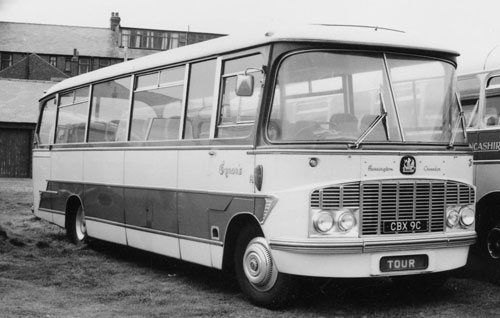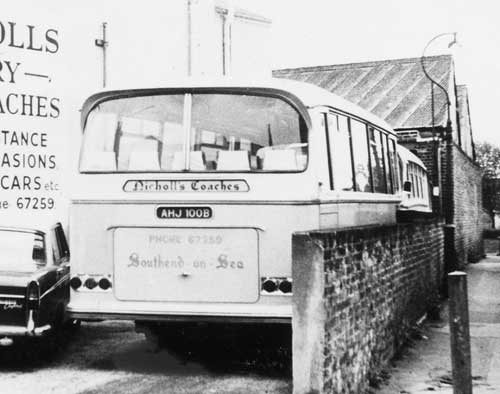During the first half of the fifties bodies on lightweight front engine chassis formed only a small part of Harrington's output. The Crusader represented a new direction and was a pivotal point in Harrington design; the Contender integral vehicle range which had been running since 1952 ceased production as Crusader started. The name, the first in a succession based on men at arms was a clue that this was the start of a fresh design sheet and a change from the past policy of fitting a variation of their proven heavy weight designs to the lighter chassis. It was the first design that was intended only for lightweight chassis such as the Commer Avenger, Bedford SB and Ford Thames. There was no Crusader version on a heavy / medium weight under-floor engine chassis. It represented a more concerted effort to gain ground in the lightweight market, dominated by Duple. Perhaps fortunately at this time the Duple Vega range was looking unfashionably bulbous and the Crusader, while not exactly sleek was certainly rakish. Also it is likely that Harrington were aware that this segment of the market was about to expand with Ford about to enter the PSV arena and Bedford offering a Leyland engine option for the SB (which was of great interest to Grey Green, a long standing Harrington customer).
The Crusader ran to four marques and it is rare to find full agreement that any of the four were really good looking. The booby prize probably goes to the rare MkIV. By the time this came out the Crusader had tried to metamorph into a baby Legionnaire - indeed had Harrington continued in business it is likely this would have been much more obvious. The Mk IV also had a dash of Duple Bella Vista thrown in around the sides; the successful Duple design having vanquished nearly all pretenders to the lightweight throne.
The Crusader Mk1
The Crusader mark 1 was introduced at the 1958 Commercial Motor Show and was an interesting styling watershed. It drew heavily on the general styling of the still current Wayfarer Mk4 but at the same time displayed many of the features that barely a year later would be drawn together harmoniously into the Harrington Cavalier. There is no doubt that the Cavalier, yet to be announced at this time, was one of the most important new coach designs of the era both for Harrington and coaching in general. The Crusader has been largely ignored by transport historians but has its place as the link between Harrington's production in the 1950s and the new decade.
Pictured, standing awaiting delivery is Bedford, TWN 741. It is an early body number, 2079 and on chassis SB 8 69836. It is destined for Davey of Swansea.
One of the important features pioneered on the Crusader and later used on the Cavalier was the introduction of a very much more sophisticated window pan for the side windows. This was not only stronger than the flat panel of the Wayfarer, but also managed to impart an air of quality, thanks mostly to the specially made rubber extrusion which sat neatly into the frame.
The large one piece front and rear panels as well as the front and back roof sections, were entirely made out of fibreglass and the novel angular shape of the rear window surround took full advantage of the versatility of this medium. Certainly the rear looked very "modern" compared with previous Harrington designs and those of other manuufacturers who, with varying success, were still struggling to find a look different from the rounded "dome". It was clear that Harrington realised this was the strong point of the design and advertisements for the Crusader usually featured a rear angle. Crusader frontal styling was clearly descended from the Wayfarer IV but surprisingly, the front grille was a bit of a throw back to the Wayfarer Mk3; generally thought to be an unsuccessful design.
In the Crusader great efforts were being made to keep both weight and costs down. The seat frames were simple square section tube and this formed the seat legs too, instead of the usual "deluxe" aluminium casting. "Formica" plasic laminate was used more extensively than the Wayfarer IV, where it had first been seen. It was used not only on the plywood that formed the dash board but along the interior without any backing at all on the inside of the frame around the windows. Below the window line the interior lining panels were made of Rexine covered hardboard - something not seen since the end of the wooden framed bodies. The Crusader may have been metal framed but without the aluminium inner panel the general solid feel that Harrington coachwork had previously imparted was more obvious. When diesel versions of the Crusader were standing ticking over they used to shudder dreadfully. Although this was no more than contemporary lightweights from other manufacturers, the fact that many customers had other sorts of Harrington coachwork meant that the Crusader was viewed with slightly less enthusiasm by drivers and passengers alike. This may also be a reflection on the engines fitted to the diesel version of the Bedford chassis, of course!
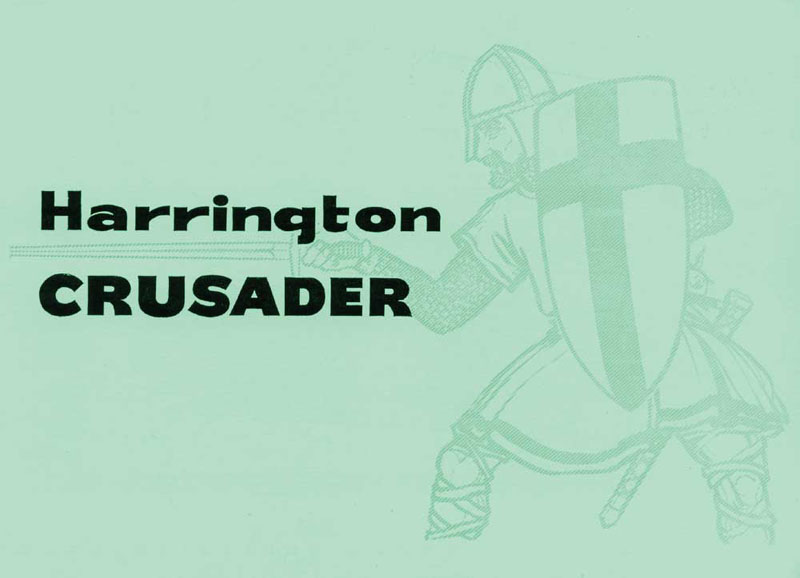
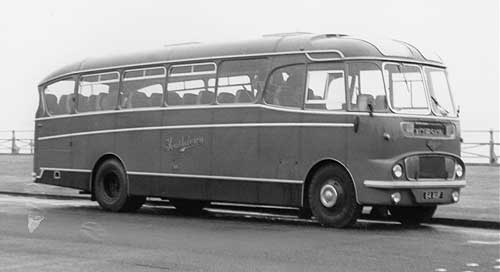
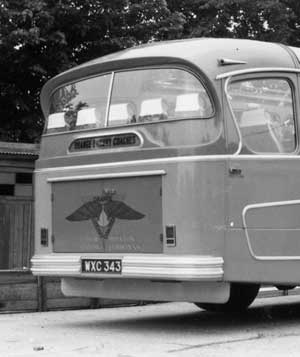
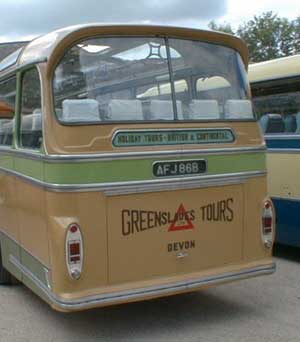
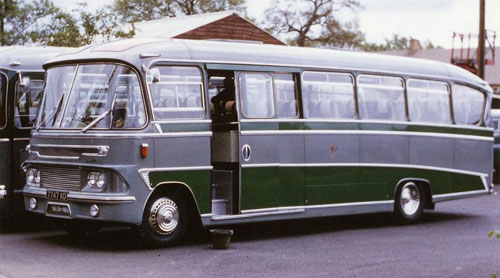

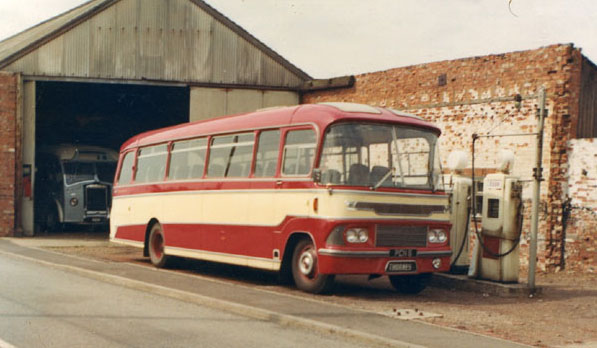
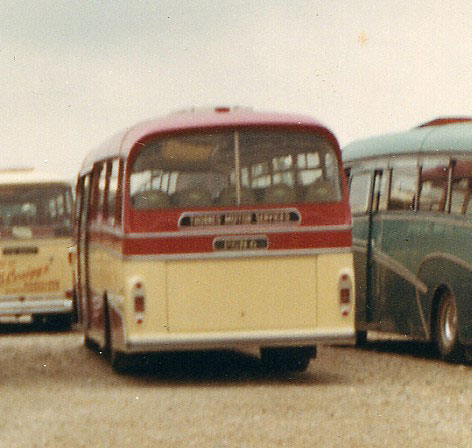 The change to the Mark 3 was achieved by dipping into the Cavalier parts
bin. The side appearance was improved by longer windows which gave a less
cluttered appearance. The back was in effect now exactly the same as the
Cavalier. Unfortunately the Grenadier had just arrived which started to
make the Cavalier look dated! However since only a handful of Grenadiers
were made during 1963, this was not immediately obvious.
The change to the Mark 3 was achieved by dipping into the Cavalier parts
bin. The side appearance was improved by longer windows which gave a less
cluttered appearance. The back was in effect now exactly the same as the
Cavalier. Unfortunately the Grenadier had just arrived which started to
make the Cavalier look dated! However since only a handful of Grenadiers
were made during 1963, this was not immediately obvious.